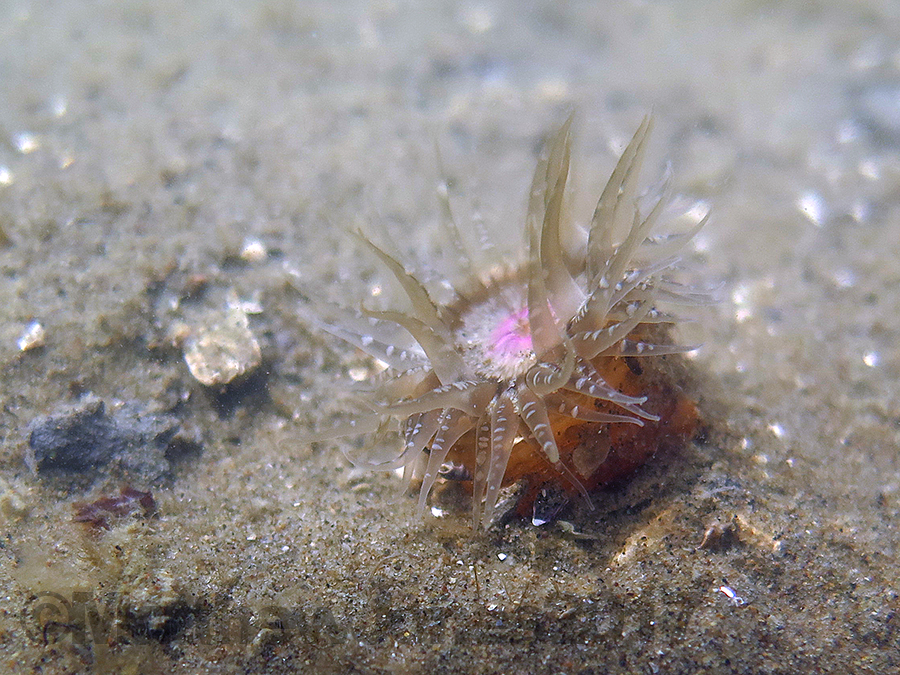Rose Anemone
Anthopleura roseaDescription 2
Common, small anemone.
Habitat
Under stones in sheltered places in fine gravel or coarse sand. In places where coarse sand meets stones.
Pedal disc
Adherent, light coloured, wider than column.
Column
Varies from white/grey to bright orange or olive-green. Has lines of white verrucae, adhesive bumps, from top to bottom to which shell fragments and grit stick.
Has light coloured marginal spherules at base of tentacles.
Oral disc
Flat or slightly concave yellowy-white oral disc with 12 radiating darker lines from a similarly dark ring around the white mouth.
Tentacles
48 tentacles arranged in 3 whorls. Rosey pink, blotched with brown and white, appear banded.
Distribution
Endemic, throughout NZ.
Zooxanthellae not present.
Description extracted from Transactions and Proceedings of the Royal Society of New Zealand 1868-1961, Volume 42, 1909, p541
Art. LV.—Notes on a Collection of Sea-anemones.
By F. G. A. Stuckey, M.A., and C. L.Walton.
Pedal Disc
Adherent to rocks.
Column
Olive-green, orange-brown, or umber. Covered with warts; most numerous about middle of column. The warts have suckers, to which particles adhere. There is a row of white spherules on the margin.
Oral Disc
Yellowish-white, with 12 darkumber rays, united in the middle of the disc by a circle of the same colour, thus producing a wheel-like pattern. The rays split in two. Stomodœum.—The mouth is raised on a cone.
Tentacles
In three whorls, 40 to 50 in number; probably 12+12+24 in normal specimens. They are thick at the base, and taper to a point. The colour is rosy red, brightest at the tip and dull umber at the base. They are irregularly marked on the inner surface with bars and spots.
Size
Height of column, 5 mm.; diameter when fully expanded, 18 mm.; diameter of oral disc, 7 mm.; longest tentacle, 6 mm.
Reproduction
This species has been observed by us to increase by fission.
Distribution
Pukeroa and neighbourhood.
Edited version of Records of the Canterbury Museum, Vol 6, No 1, p106-7, Nov 1951
Article: The Actiniaria of New Zealand - a check-list of recorded and new species, a review of the literature, and a key to the commoner forms Part 1
By G. Parry. :
Habitat
The species is found commonly under stones, in sheltered places, embedded in fine gravel or coarse mud. It is just below tide level, except occasionally.
Pedal Disc
Adherent, often buried in mud, etc., and cream in colour. It is a little wider than the collar, which is pillar shaped in expansion.
Column
Verrucae in longitudinal rows, to which particles are attached. Colour very variable, from white or grey, to bright orange, olive green, etc. The verrucae are white. At the top of the column, lying within the well-marked fosse, is a ring of white spherules.
Oral disc
Flat or slightly concave, with raised peristome. Colour is creamy white with 12 dark brown rays running out from the dark brown peristome. Throat is white.
Tentacles
Fairly short, and taper to a fine point. They are 40-50 in large specimens, in three cycles (12, 12, 24). They are a rosy pink colour, translucent, and irregularly marked with brown and white spots. These spots are more numerous at the base of each tentacle, and disappear towards the tip.
Reproduction
The reproduction of this species, according to Stuckey and Walton, is by fission, although I have myself seen no evidence for this.
Distribution
It has been found at Menzies Bay, Portobello (Otago Harbour), Onehunga (Auckland), and Pukeroa and neighbourhood (Stuckey and Wilson)
References 2
Note any thumbnails in this section are only to indicate what that reference shows while this page is being built. They have not yet been verified, don't assume they are correct examples.
- https://marineinfo.otago.ac.nz/cards/cid/366/
- http://www.marinelife.ac.nz/species/1112
- http://rsnz.natlib.govt.nz/volume/rsnz_42/rsnz_42_00_005120.html (as Bunodes rosea)
http://www.rodmorris.co.nz/search#q=Anthopleura+rosea
http://www.rodmorris.co.nz/New-Zealand-Seashore/New-Zealand-Seashore/n-2GZnF/i-Fs96mMJ

- https://shapeandtheidea.wordpress.com/2018/06/22/rose-anemone-anthopleura-rosea/

- NZ Coastal Marine Invertebrates Vol 1 by Steve de C. Cook, p154
-
Anthopleura radians, a new species of sea anemone (Cnidaria: Actiniaria: Actiniidae) from northern Chile, with comments on other species of the genus from the South Pacific Ocean by Carlos Spano1 and Vreni Häussermann
Biodiversity and Natural History (2017) Vol. 3, No. 1, 1-11
- Records of the Canterbury Museum Vol 6, No 1, p107-8, Nov 1951, The Actiniaria of New Zealand by G Parry
Synonyms:
- Bunodactis rosea
- Bunodes rosea
Sources and Credits
- (c) Tony Wills, some rights reserved (CC BY-SA), uploaded by Tony Wills
- (c) Tony Wills, some rights reserved (CC BY-SA)



